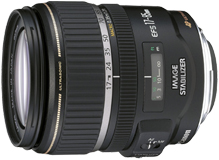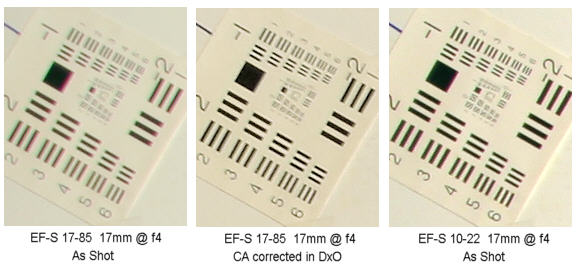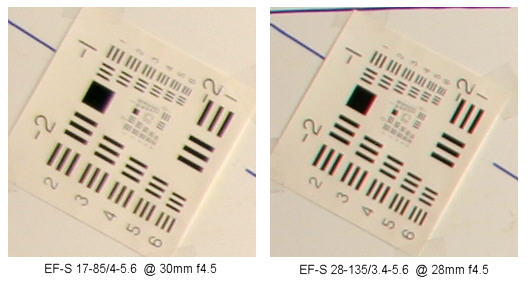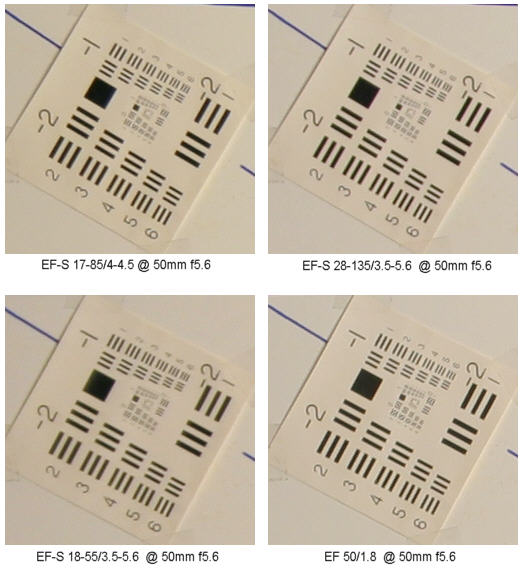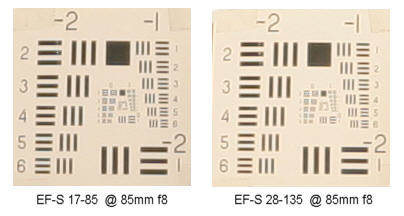
Canon EF-S 17-85/4-5.6 IS USM Lens Review |
Canon EF-S 17-85/4-5.6 IS USM Review
SharpnessThe observations below are based on looking at a large number of images and evaluating them both visually (at 200% resolution on screen) as well as doing more detailed image analysis with software such as Imatest. I did not compare the 17-85 with the 17-40L because I did not have one available when the tests were done, but I do make some comments on the 17-40L in the "Conclusions" section of this review. I've included some 100% crops (shot using an EOS 20D) from the corners of the frame, which is where the lenses showed most difference. Image quality in the center of the frame was very similar for all lenses testes, and could well be determined more by sensor resolution than lens quality. 17mmI looked at the EF-S 17-85, EF-S 10-22 and EF-S 18-55 at 17/18mm. The winner here was the EF-S 10-22, especially at f4. It showed higher corner sharpness and lower lateral chromatic aberration than the other two lenses. Second was the EF-S 17-85 and the EF-S 18-55 came in third. In the center of the frame at f4 all three lenses were quite similar. Stopping down doesn't affect lateral chromatic aberration of course, but it did sharpen up the corners of the frame a bit. Of course this is the digital age and lateral chromatic aberration isn't what it once was in terms of a problem. Many image editors and processors including, for example, PhotoShop, Picture Window Pro and DxO, can greatly reduce the effects of CA (chromatic aberration). CA results from the red, green and blue components of the image being very slightly different sizes. By adjusting the size of each color image, CA can be greatly reduced as shown below.
As you can see, in the corner of the frame the "as shot" image from the EF-S 10-22 is certainly better than that from the EF-S 18-85. However by running the image through a CA removal program (in this case I used DxO), image quality is greatly improved. CA is virtually gone, which results in an increase in contrast and perceived sharpness. 28mmAt 28mm I compared the results from the EF-S 17-85/4-5.6 IS to those from the EF 28-135/3.5-5.6 IS. The EF 28-135/3.5-5.6 IS is regarded as one of the better mid range consumer zooms and covers a full 35mm frame. Image quality was very similar \, both in the center of the frame and in the corners. Both lenses showed mild chromatic aberration in the corners, with the EF-S 17-85 showing slightly less than the EF 28-135. Contrast and resolution were similar Both lenses were slightly sharper when stopped down to f8.
The above images show corner quality at f4.5. Image quality and resolution are very similar though the EF-S 17-85 shows slightly lower chromatic aberration. 50mmAt 50mm I compared the EF-S 17-85/4-5.6 IS, the EF 28-135/4-5.6 IS, the EF-S 18-55/3.5-5.6 and the EF 50/1.8. As you might expect, at f5.6 the 50mm f1.8 prime lens was the best, especially in the corners of the frame, however the difference was not huge. The EF-S 17-85/4-5.6 IS and the EF 28-135/3.5-5.6 IS were very similar. Chromatic aberration was low with both lenses, but the 17-85 was very slightly better. The performance of the EF-S 18-55 was only very slightly worse than the other lenses.
85mmAgain at 85mm the performance of the EF-S 17-85/4-5.6 IS and EF 28-135/3.5-5.6 were quite similar. Both center and edge quality was good and chromatic aberration was low. Just for a change, here are center crops at f8:
As you can see, there's very little difference in image quality, and the same applies to the edges and corners at 85mm. NotesJust as a matter of interest, the image below indicates the "lines pairs per mm" equivalent resolution shown in most of these 100% crops. This particular image was from the center of the field of a 50mm f1.8 lens shot at f8 after optimizing and sharpening in PhotoShop.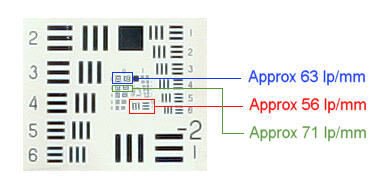
© Copyright Bob Atkins All Rights Reserved |
|
